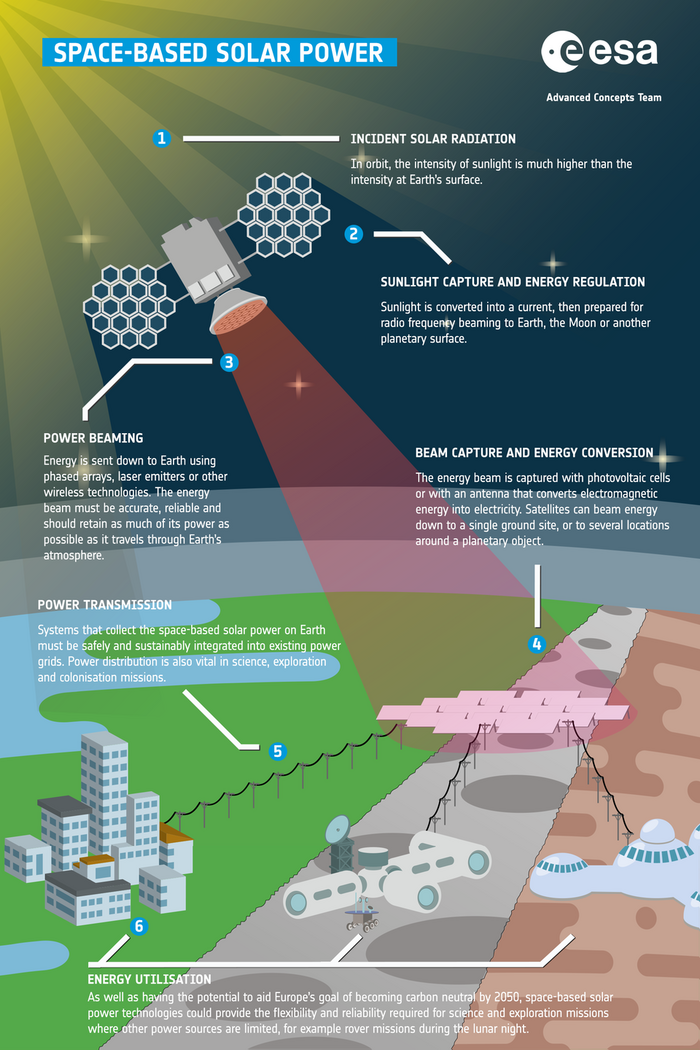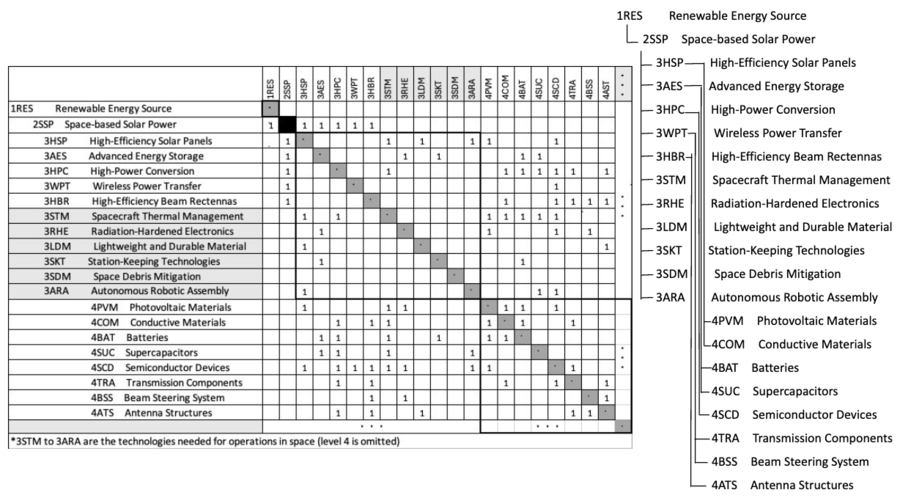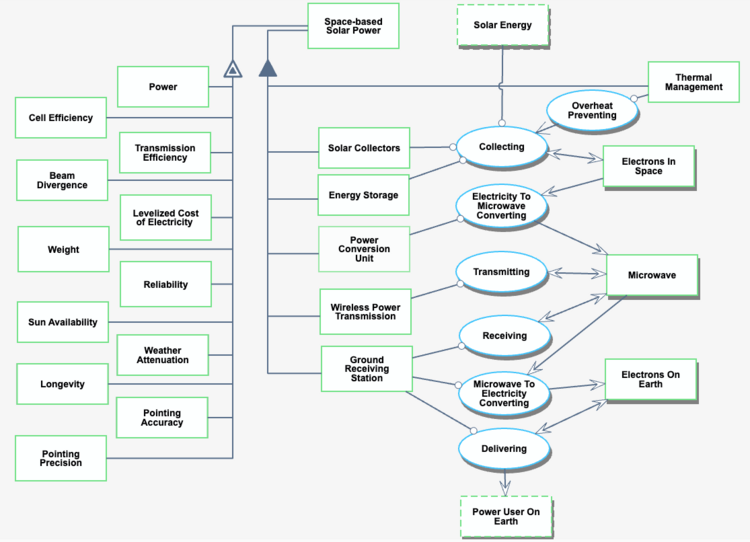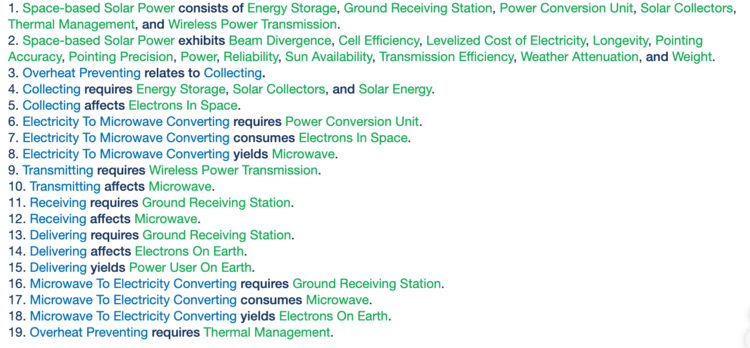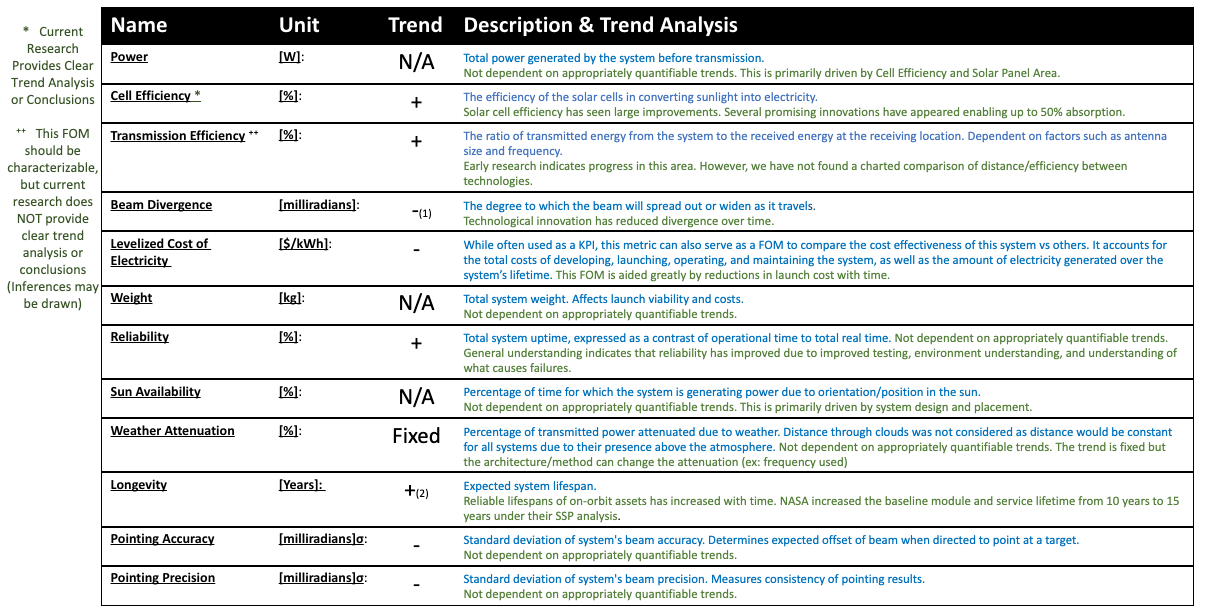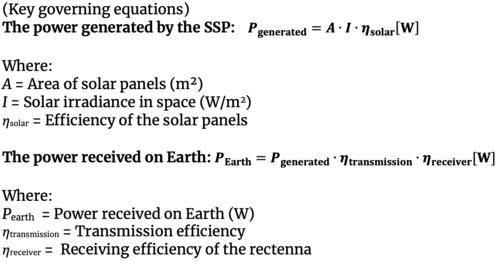Difference between revisions of "Space-based Solar Power"
| Line 96: | Line 96: | ||
The Roland Berger study for the European Space Agency (ESA) highlights the promising potential of SSP in the future energy market. According to the report, by 2050, the Levelized Cost of Energy (LCOE) for the first operational SBSP system could reach around 69 EUR/MWh ($73/MWh). Additionally, with the learning curve effect, the LCOE might decrease to approximately 49 EUR/MWh ($52/MWh) after deploying the first 10 SSP stations. | The Roland Berger study for the European Space Agency (ESA) highlights the promising potential of SSP in the future energy market. According to the report, by 2050, the Levelized Cost of Energy (LCOE) for the first operational SBSP system could reach around 69 EUR/MWh ($73/MWh). Additionally, with the learning curve effect, the LCOE might decrease to approximately 49 EUR/MWh ($52/MWh) after deploying the first 10 SSP stations. | ||
This suggests that SSP could achieve a competitive LCOE compared to other power generation technologies.The economic viability of SSP will depend on factors such as climate policy implementation and future energy supply conditions. The study outlines scenarios with electricity prices ranging from 25 to 300 EUR/MWh (~$27 to ~$319/MWh), indicating that | This suggests that SSP could achieve a competitive LCOE compared to other power generation technologies.The economic viability of SSP will depend on factors such as climate policy implementation and future energy supply conditions. The study outlines scenarios with electricity prices ranging from 25 to 300 EUR/MWh (~$27 to ~$319/MWh), indicating that SSP could be economically competitive within this range. | ||
Regarding Power Output Capacity, while detailed data is not yet available, SSP’s potential for continuous power generation in space—unaffected by the Earth’s day-night cycle or atmospheric conditions—could lead to significantly higher capacity factors. This continuous generation could enable SSP to achieve substantial and consistent power output, potentially rivaling or surpassing traditional baseload power sources. | Regarding Power Output Capacity, while detailed data is not yet available, SSP’s potential for continuous power generation in space—unaffected by the Earth’s day-night cycle or atmospheric conditions—could lead to significantly higher capacity factors. This continuous generation could enable SSP to achieve substantial and consistent power output, potentially rivaling or surpassing traditional baseload power sources. | ||
Revision as of 15:01, 3 November 2024
Technology Roadmap Sections and Deliverables
- 2SSP - Space-based Solar Power
We’ve chosen the acronym 2SSP to represent our technology of Space-based Solar Power. The 2 in our acronym implies the system level, within the level 1 system of renewable energy source. Our level 2 system level can be broken down into level 3 subsystems (high-efficiency solar panels, wireless power transfer, etc.) and level 4 components (photovoltaic materials, antenna structures, etc.).
Roadmap Overview
The working principle of Space-based Solar Power is depicted in the below.
This technology transforms solar radiation into energy using the solar panels on a spacecraft, which then wirelessly transmit the energy to a receiving ground station. The captured energy is then converted to electricity before storage and/or distribution.
The large solar array would take advantage of the higher intensity of sunlight outside the planet's atmosphere, as well as unimpeded access to the sun that is unconstrained by the day/night cycle. The electricity is then channeled to a transmitter for long distance wireless transfer via a focused and steerable beam – a key technical challenge. On Earth, the energy would be received and converted back to electricity by the ground station for use.
| Number | Potential Use Cases |
|---|---|
| 1 | Simplify energy delivery to remote areas |
| 2 | Provide more consistent solar power to high latitudes |
| 3 | Provide disaster relief to areas with damaged infrastructure |
| 4 | Recharge other satellites on orbit |
Design Structure Matrix (DSM) Allocation
The 2-SSP tree that we can extract from the DSM above shows us that Space-based Solar Power (2SSP) is part of a larger initiative on renewable energy sources (1RES). It requires the following key enabling technologies at the subsystem level: 3HSP High-Efficiency Solar Panels, 3HPC High-Power Conversion, and 3WPS Wireless Power Transfer (e.g., this includes the management of energy distribution and efficiency). In turn, these technologies require enabling components at level 4, the technology component level: 4PVM Photovoltaic Materials, 4SUC Supercapacitors, 4SCD Semiconductor Devices, and 4ATS Antenna Structures, etc.
[Interdependencies with other roadmaps]
Potentially required for assembly:
[3SB] - Space Booms
Potentially required for assembly:
[3OORR] - On Orbit Refueling and Repositioning
Will aid debris avoidal capability:
[2GREAT] - Ground Based Radar For Space Situational Awareness
Will aid debris avoidal capability:
[4DAA] Detect And Avoid Autonomous Augmentation System
Necessary for reaction control system:
[2SEP] - Space Electric Propulsion
Necessary for spacecraft thermal control
[4VEM] - Variable Emissivity Materials for Spacecraft
Roadmap Model using OPM
In the figure below, we provide an Object-Process-Diagram (OPD) of the 2SSP roadmap. This diagram captures the main object of the roadmap (Space-based Solar Power), its various instances, including main competitors, its decomposition into subsystems, its characterization by Figures of Merit (FOMs), as well as the main processes (Transmitting, Receiving, etc.).
Figures of Merit
The table below shows a list of FOMs by which space-based solar power can be assessed. The table also contains the FOM trends as well as the key governing equations that underpin the technology.
Alignment with "Company" Strategic Drivers : FOM Targets
SSP is designed and developed as a fundamentally disruptive technology, leveraging a combination of advancements in solar cell efficiency, wireless power transmission, space-based construction, and other enabling technologies. To be commercially viable, SSP must demonstrate significant scalability to address large energy demands and be able to significantly reduce cost per unit of energy.
Positioning of Company vs. Competition: FOM charts
This chart illustrates the comparison between the Levelized Cost of Electricity (LCOE) and the Power Output Capacity for various power generation technologies. The X-axis represents the LCOE values in USD per megawatt-hour (MWh), sourced from the U.S. Energy Information Administration (EIA) report. LCOE is a key indicator of the cost-effectiveness of different power generation methods, considering the total lifetime costs divided by the total electricity output over the plant’s operational life. The Y-axis represents the Power Output Capacity in megawatts (MW), which indicates the maximum electrical output that each type of power plant can generate. Since the capacity depends on the scale and specific design of each facility, the chart displays a range of typical values as a reference for each technology. These ranges reflect the variety of installations, from smaller local plants to large-scale facilities.
The Roland Berger study for the European Space Agency (ESA) highlights the promising potential of SSP in the future energy market. According to the report, by 2050, the Levelized Cost of Energy (LCOE) for the first operational SBSP system could reach around 69 EUR/MWh ($73/MWh). Additionally, with the learning curve effect, the LCOE might decrease to approximately 49 EUR/MWh ($52/MWh) after deploying the first 10 SSP stations.
This suggests that SSP could achieve a competitive LCOE compared to other power generation technologies.The economic viability of SSP will depend on factors such as climate policy implementation and future energy supply conditions. The study outlines scenarios with electricity prices ranging from 25 to 300 EUR/MWh (~$27 to ~$319/MWh), indicating that SSP could be economically competitive within this range.
Regarding Power Output Capacity, while detailed data is not yet available, SSP’s potential for continuous power generation in space—unaffected by the Earth’s day-night cycle or atmospheric conditions—could lead to significantly higher capacity factors. This continuous generation could enable SSP to achieve substantial and consistent power output, potentially rivaling or surpassing traditional baseload power sources.
Technical Model: Morphological Matrix and Tradespace
Keys Publication and patents
References
[1] Pereira, R. A. M., & Carvalho, N. B. (2022). Quasioptics for increasing the beam efficiency of wireless power transfer systems. Scientific Reports, 12(1), 21138. https://doi.org/10.1038/s41598-022-25471-0
[2] NASA. (2023, October 5). New study updates NASA on space-based solar power. NASA. https://www.nasa.gov/organizations/otps/space-based-solar-power-report/
[3] European Space Agency. 2023. Space-based solar power: seeking ideas to make it a reality. ESA. https://www.esa.int/Enabling_Support/Preparing_for_the_Future/Discovery_and_Preparation/Space-based_solar_power_seeking_ideas_to_make_it_a_reality
